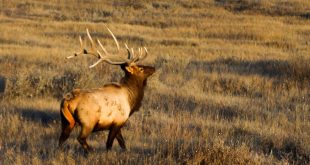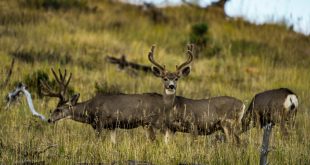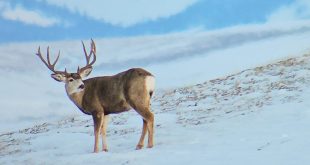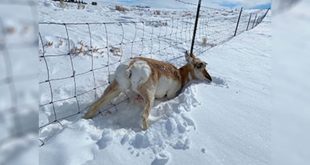
Circa. 1960 – As my father and I drove towards Cora, Wyoming I had vivid dreams of hunting giant snow-bound mule deer bucks. Although only 12 years old and not yet legal to hunt for another two years it was a true treat for me to even be allowed to tag along on such an adventure with my father. Our final destination was to be the famed Red Desert for the late season deer hunt. However, let it be noted that I later found out he brought me alone not so much for companionship but for my ability to help shovel out the snow-bound truck and help to put on the shiny truck jewelry – aka chains. Our “old school” rig, a bright shiny new 1958 yellow half-ton two-wheel-drive Chevy pickup steadily groaned down the ice-packed highway at a blazing rate of nearly 35 miles per hour. Dad would have to pull over and scape the windshield from the inside about every 30 minutes, further expanding the painfully long dark drive to our destination.
I knew what I was in for on one of these excursions, however. Whenever Dad would get stuck in the massive snowdrifts out came the shovels with me doing most of the digging and pushing. You see my father always pushed the envelope. Whether guiding in Alaska in the ‘50s and going down in the Arctic Ocean or helping to open up the Northwest Territory to hunting. So, when it came to hunting the late season desert it was always pedal to the metal until we got no farther. This meant I could easily count on at least two, three or maybe four times worth of shoveling and excruciating pushing sessions on the old Chevy desperately trying to get it out of snow drifts each and every day of hunting.
In 1960 the local rumor was that massive volumes of mule deer would pile out of the numerous Wyoming mountain ranges slowly following the creek drainages down to the massive wind-swept openness of the Red Desert of southern Wyoming each December.
It was the 15th of December as we stopped at the small town of Cora, Wyoming to fuel up with gas. A large round thermostat on the side of the gas station pointed to -31 degrees.
As the station attendant came out all bundled up like the Pillsbury Dough Boy, Dad jumped out of the tuck and said, “I hear there is a lot of mule deer around here. Where can I find them?”
The attendant gave him a funny look and said as he stretched his hand up and moved it around in a big circle, “Just look around man!”
After blowing a peep hole in the thick, frosty passenger side window, I eagerly gazed off in the distance to find on top of the snow-drenched terrain, hundreds if not thousands of tiny drifting black spots scattered throughout the distance. Just before I could identify some antlers the blow hole rudely slammed shut on me as it quickly iced back over. And to think, this was just the beginning of the winter range. As they say nowadays, I thought to myself, this could be epic…and it was.
I still believe to this day, this was the golden age of modern day western big game hunting. You see, the stars had all lined up perfectly throughout the West for a massive mule deer population expansion of epic proportions. Remember at that time almost all the western states were still extremely rural with vast expanses of ranches and vacant public lands. Overly efficient and brutal predator control was at its peak throughout the West utilizing such tools as poisons and explosives, most of which have been all but banned in today’s society. Wolves had been completely eradicated and paid government trappers were actively and effectively exterminating the coyote population. Except for a few isolated mountainous areas, the entire cougar population was nearly exterminated from top to bottom by trappers, hunters and livestock producers. Add to that, a nearly decade-long lack in the supply of hunters out West due to the onset of a world war and very limited vehicular travel and minimal road systems in most rural areas, along with drastic fire suppression measures had opened the door to a monumental explosion of the deer population never before seen in the West.
By 1970, the liberal hunting seasons on the many winter ranges throughout the west had begun to decrease deer populations in Wyoming. In the late ‘60s after a two year stretch in Viet Nam, I anxiously arrived back to Jackson Hole, Wyoming in 1970 to no more liberal hunting seasons that ran clear into December on the winter range. In my early teenage years, I had hunted in the high country where these bucks summered. By the ‘70s there was a marked decrease in high country mule deer numbers. Being an outfitter in the early ‘70s I was able to track the movements of mule deer from the high country on down and out to the Red Desert.
During one of those hunting seasons around the 20th of October we had an early snowstorm that lasted 10 days in the mountains around Jackson Hole, Pinedale, and Afton. When it cleared off the temperature proceeded to drop to a very unseasonable 20 below zero. I was able to easily follow the mule deer tracks in the snow as they migrated early out of the backcountry mountains ranges of western Wyoming. The Hoback, Wyoming Range and Salt River Ranges all emptied their deer out and over the Hoback Rim and down into the historic Red Desert winter range. That’s when I realized that a vast majority of the deer in these particular mountain ranges made the yearly migration down into the Red Desert for the winter.
That week I had five mule deer hunters who in one single day after that historic snow storm killed five trophy mule deer bucks in a single morning. It was just like those 1960’s hunts that I remember as a young man prior to my tours in Vietnam. We caught hundreds, if not thousands of deer desperately migrating out of those rugged, snow-caked mountain ranges. Fortunately, the G&F realized this was a problem and that was the last year there would be legal hunting permitted in these critical migration corridors in late October.
In my book Hunting High Country Mule Deer published in 1995, chapter 19, I predicted the following: “Hundreds of the deer from the south part of the Salt River and Wyoming Ranges are hit by cars and semi trucks as they attempt to cross major highways trying to get to their historical winter range. Hundreds of deer! Studies on winter range vegetation are ongoing, but little consideration is given to the study of migration routes.”
But it’s not too late! Fast-forward 25-years, researchers are finally able to identify these historic wildlife migration routes. A dedicated group of wildlife biologists and scientists headed by Matthew Kauffman of the US Geological Survey at the University of Wyoming have done extensive migration studies of mule deer from the Red Desert back to their historical summering range. Some of these deer will migrate nearly 200 miles from their critical winter range to their high-country summer range every year. After documentation and study of these migration routes, scientists and biologists are finding out that these routes are extremely predictable and very crucial and change very little from year to year. Most of these animals will not easily change their migration routes and will die trying if necessary. Along with this, researchers are no able to identify critical pinch points that create difficult obstacles for the deer to continue on their migration routes.
With the help of funding from many different sources, mostly through sportsmen’s dollars, researchers are now able to identify and purchase land and conservation easements at these pinch points in these crucial migration choke points. As we speak, the Wyoming Migration Incentive is documenting many other crucial migration routes and corridors throughout the West not only for mule deer, but for antelope, elk, moose and sheep. These researchers and biologist need our help! It doesn’t do any good to plant bitterbrush on the winter ranges if these herds can’t manage to migrate there in the first place the WG&F Department and the Wyoming Migration Incentive need continued funding to allow them to not only identify other critical migration routes, but also to purchase critical pinch points and obstacles along these these routes.
The time is now. No other time in history would a study of this magnitude and scope even be possible because of detailed satellite tracking capabilities and modern computing and imaging technology.
This ground-breaking study of Wyoming’s historic and record-breaking mule deer migration has spurred other states to create studies of their migration routes that are also affected by man-made and man created obstacles.
The good news, is that many of these problems are somewhat easily solvable once they are identified and prioritized. This very critical work needs to continue and will make a big difference in beginning to bring back our mule deer herds throughout the West and in western Wyoming in particular.
Keep an eye out for Imperiled, our latest film project focusing on the findings and complexities of these ground-breaking studies and what these scientists are finding out about our mule deer, and the importance of their critical migration routes. The film will be available later this year on YouTube and premiering on Outdoor Channel around the first of the year.
#1. Most mule deer migration routes continue to be obstructed with fences.
#2. Wyoming’s historic mule deer migration.
#3. Fences continue to be obstacles to the West’s mule deer migration routes.
#4. Wyoming’s mule deer migrations have been documented to be nearly 200 miles from high country summer range to the Red Desert
#5. In 1960 the deer hunting season in Wyoming ran until the end of December. This buck was harvested in 1960 near Big Piney, Wyoming on the winter range.
#6. 1969 – Gordon Eastman with a late season trophy buck killed in Teton Creek.
#7. 1965 – Gordon Eastman with another late season Snake River, Wyoming buck well before the onset of the hunter orange requirement.
#8. On December 15, 1965 we braved ice flows to float cross the Snake River south of Jackson, Wyoming to hunt late hunt wintering bucks. On this particular day it was 28 below zero.
#9. 1973 – Mike Eastman with a trophy buck from the winter range south of Jackson, Wyoming it was -31 degrees that day at the end of November.
#10. On the 20th of December 1966 and 28 below zero yielded this big buck by floating across the Snake River Canyon south of Jackson, Wyoming. The buck was a 30” wide mainframe and went in the B&C records book. At that time the records book minimum was 185” net.
#11. During the 1960 hunting season, which ran until the end of December, this buck was found near Big Piney Wyoming on the winter range.
#12. Mule Deer on the Red Desert winter range at over 100 air miles from the deer’s high-country summer range.
 Eastmans' Official Blog | Mule Deer, Antelope, Elk Hunting and Bowhunting Magazine | Eastmans' Hunting Journals
Eastmans' Official Blog | Mule Deer, Antelope, Elk Hunting and Bowhunting Magazine | Eastmans' Hunting Journals





Mike great synopsis of mule deer status. The massive decline has been very concerning compounded by CWD as well. The 2 decades of drought and lack of quality forage is very apparent in the areas I hunted for decades.
Looking forward to “Imperiled” and continued study and suggestions for improving mule deer numbers. The animals can be resilient with some added help I hope !
First of all, please explain why the US Geological Survey is doing wildlife studies? Secondly, I am an ethical hunter myself and wth ink anyone who hunts wildlife of any kind in -31 degrees is not only an idiot but has zero respect for wildlife. Don’t act like your doing anything important for wildlife when you have no ethics whatsoever.
Kent, consider the context of this kid in 1960. With today’s technology, mapping, ATVs, long range calibers, premium optics it may be different, but back then there was very few voices of conservation at all.. They didn’t even have four wheel drive!
Hey Kent, are you saying hunting in negative temperatures is unethical? I grew up hunting northeast Montana and spent the past 18 years hunting western North Dakota. Often, we’ll start November deer season in the negative temps. I know our friends to the north also have some interesting hunting seasons in the brutal temps of winter. I’m not sure what is disrespectful about hunting ungulates in their native habitat. Can you explain?
In this case, the deer were being killed in severe conditions as they migrated to the winter range. And I understand that people hunt in cold weather in northern states especially. However, ambushing them in -30 temps as they are fighting to survive could very well be the reason they are scarce! And don’t forget the deep snow that the author bragged about shoveling. And finally, taking a kid hunting in conditions like that is foolish, reckless, and could easily result in death of the hunter, not the hunted.
First of all Kent, when I was a kid, we walked to and from school in those temperatures 6 months out of the year. Its our culture. We also drill oil, build houses, and ice fish in those temperatures every year. Life their never stops. There is always a risk, but for us the cold, is not as bad as the rest of the country makes themselves think it is.
These ungulates are designed for winter. There bodies naturally store extra fat and grow an extra under coat to protect them from extreme temperatures. In the north, these animals survive temperatures not just 30 below, but in many areas across the Midwest and Canada, -50 – -60 below regular temp, not wind chill. Most winter kills happen in an area that might receive too much snow, burying precious vegetation and covering their resources with a layer of ice, forcing starvation. hence the reason these ungulates leave the high country and seek lower elevation. They are not surviving, they are just living. Their are other ethical reasons we might not hunt them on their winter range. The hunt is about the chase, and we believe in fair chase.
Things have changed and our regulations have changed to help progress our good stewardship of those things entrusted to us by God. it does not help the future if we are constantly criticizing the past. Learn and move forward, don’t stay there.
Who am I to criticize the past adventures of another man and his son? I should find ways to make my own.
Yeah, well it’s not -30 for six months where you fish and hunt but nice try. Yes, things change but hunting mule deer at -30 as they migrate to winter range was never a good idea. Did the story reflect on that fact? Let’s face it… the story was meant to inflate the ego of the author. Again, say what you want but trying to kill any wildlife who are trying to survive severe conditions is really bad sportsmanship. End of story.
Well, Kent, that is your perogative. Everybody draws their line somewhere and this seems to be beyond yours. It’s pretty clear that all of the other respondants to this post disagree with you.
Thank you Mike.
I appreciate your dedication to wildlife, both financially and at the podium.
Please continue your great efforts.
Not sure how these digress continually into some negative idiot chiming in to find some perspective 40 years removed. What a clown ! People used to smoke on planes and restaurants etc. different time different lens ! Moron ! I lived and hunted in Alaska for a long time and extremely cold hunting was the norm. Those damn natives survived for thousands of years hunting sub zero conditions. If people now understand the impacts you cannot look at history and judge it – douche !
Nice response Mr. Anonymous Orion. If you hunt in -31 temperatures, you’re the idiot. All you tough guys out there, good luck. You’ll all survive the next ice age!
You sound like a bunny hugger Kent. If hunting in temps well below zero is unsportsmanlike then I guess I’m guilty as charged. What was legal to do 50/60 years ago is quite different than what is allowed by the Wyoming G&F today. Wildlife management has come a long, long way. Habitat is the key these days IMO.
No, I do enjoy big game hunting. I just happen to do it in a respectful and ethical way. And Darwin’s Theory would suggest that those who take their spawn hunting in -31 temperatures will be naturally removed from the gene pool.
Are there any private organizations supporting this critical research? I would like to donate to the cause. Links?
Mike Eastman didn’t hurt the mule deer numbers in wyoming back in the 60s and 70s…..he did it In the 90s not by telling guys how to hunt….but by telling them exactly where to hunt ….and wyoming game and fish are equally complicit for sell a tag to every out of stater who could afford one
The Eastman and the wygaf sold out a entire half of a state for the dollar……now wonder the small town Jackson hole kid has to reside on the other side of three mountain ranges and the state…..he’s not loved here